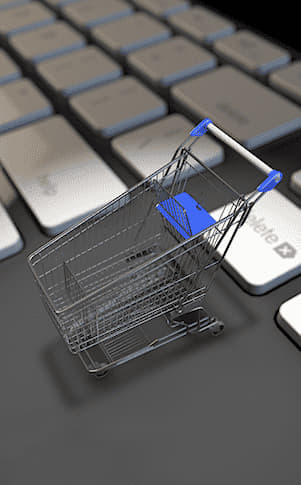
As long term readers to this blog will know, most of my working day is spent talking with business owners or marketing managers.
Subjects can range anywhere from whether I think they should redesign their website to generate more traffic, to why their Facebook ads are underperforming.
But the single biggest inquiry we get as an agency is from owners of e-commerce sites. And, since it’s the most ubiquitous e-commerce platform around, that usually means Shopify.
Before we continue, a quick nod of appreciation to the other shopping platforms. Hi there BigCommerce, PrestaShop, Magento, plugins like WooCommerce, or site builders with e-commerce features such as SquareSpace. We love you guys too, and think you’re awesome. But for many people, when they think of e-commerce platforms they think of Shopify. It’s a bit like referring to a photocopy as a ‘Xerox’, a tissue as a ‘Kleenex’, or a vacuum cleaner as a ‘Hoover’.
The Explosion Of E-commerce
The growth in online selling isn’t anything new. Jeff Bezos has been making billions from it for ages. The fallout from COVID-19, however, has turbocharged a business model that was already racing along in the fast lane.
What we’ve seen with e-commerce adoption over recent years is nothing compared to what’s happening right now.
2020 saw worldwide e-commerce growth explode. Numbers released by the US Commerce Department show consumer spending via ‘non-store channels’ grew by 31.3% in the six months to November 2020, compared to the previous year. As a percentage of all retail, online accounted for 21% of it – up from 15.8% in 2019.
Take a look at this graph. What was taking years is now taking just weeks:

People who had previously never entered 16 credit card digits into a browser are now buying stuff faster than you can say “promo-code”. As I’ve mentioned before, the combination of lockdowns and social distancing due to COVID-19 accelerated the adoption of online commerce by multiple years.
Along with from Amazon (which is still in a class of its own) Shopify is riding the e-commerce wave particularly well. Shopify’s revenue for 2020 was over $2.9bn – an increase of 86% over the previous year.
It’s no wonder everyone and their dog wants a piece of that action.
Generating Better E-commerce Sales
It should therefore surprise nobody that we’re contacted by so many budding e-commerce entrepreneurs. People who’ve spent weeks setting up their online store, but just aren’t seeing marketing results.
Based on the numerous sites we’ve seen, here are some reasons why e-commerce store sales don’t live up to expectations.
Reason #1: Your site looks the same as everyone else’s
Marketing 1-01: Your site need to be remembered to stand a chance of having someone buy from you. But that’s already an uphill struggle when so many other e-commerce sites are gunning for your customers’ business. If your e-commerce site looks like a gazillion others they’ve seen, you’re making those chances of success even harder.
E-commerce platforms make it super-easy to set up a store. Pre-built theme templates, color schemes, and web-optimized typography streamline the site creation process. Even Shopify newbies can have something up and running within a few hours.
But so can everyone else. And that’s the problem.
With so many sites and few decent-looking themes, it’s inevitable your store looks and feels like some else’s – maybe even like a competitor’s. Cooker-cutters have their place, but not when you’re trying to bake a different cookie.
Sure, your logo is different. The typeface is different. But the basic design – the layout, formatting, image sizes, etc. are all the same. Déjà vu isn’t a good look when you’re trying to stand out.
What’s the solution? Make the effort to be different.
Shopify offers around 100 themes on their platform. There are also third-party themes available from places such as Themeforest or Templatemonster. On top of that, there are designers (on Shopify itself, as well other places) ready to help make your online store unique, distinctive, and differentiated.
All the above is a not-so-subtle way to remind you that the ‘if we build it, they will come‘ approach isn’t a marketing plan. It’s a prayer, and one unlikely to get an answer. It’s vital that your site stands out if you’re to have a chance of being remembered, regardless of how great your products are.
Reason #2: You don’t appear trustworthy
Before they’ll buy from you, they need to trust you. If your store doesn’t feel credible, customers will go elsewhere and are unlikely to give you a second chance.
Feelings of credibility are often intangible. Customers ‘know it when they see it’, but often can’t explain what ‘it’ actually is. Credibility factors include site design (see above), but also more subjective criteria such as messaging, or tone-of-voice. How are you describing your business, your mission, your purpose? Why are you doing what you’re doing? Once you’ve got them on side, getting them to purchase is that much easier.
Time and again we see an e-commerce site with an “About Us” page that hasn’t received much attention. What many people don’t realize is, after the Homepage and Contact page, the About Us page is the most important page on your site. It’s your chance to demonstrate to your audience what you stand for, what you’re about, and why you think you’re different.
Your About Us page is a big part of what makes your business unique. It’s the single biggest opportunity to introduce yourself and your business. It’s where you describe your business journey. It’s where you humanize your business with images or videos of you, your team, and even customers (more on that later). The About Us page is such a big part of whatever ‘credibility’ means, it shouldn’t even be up for discussion.
Why so few stores have a decent About Us page will remain one of the unanswered mysteries of our age. A bit like how ancient Egyptians built the pyramids, or the deal with the Bermuda Triangle. Or maybe why it took someone 30 years to come up with the idea for Cobra Kai.
Reason #3: No location details
We see this fundamental mistake made on perhaps 80% of the Shopify store sites we see: a ‘Contact’ page without an address.
I don’t know about you, but there’s no way I’m ever going to purchase anything from a site doesn’t list a real postal address. I’m guessing I’m not in the minority.
At the beginning of any customer relationship, especially with e-commerce, you’re not selling products. Nor are you selling your brand. You’re selling trust. Customers may never have heard of you or your business before, so they need confirmation you’re legit. Part of that assurance is being able to see where your business is located.
If you’re running your business from home and don’t feel comfortable listing those details on the internet, then get a PO box number. Sure, it’s not as good as a real address. But it’s better than having just a contact form and phone number.
Another credibility-killer we see far too often is a contact email address that doesn’t use the site’s domain. If customers are being asked to contact you via a Gmail, Yahoo, or (OMG) AOL email address, you’re sending a bad credibility signal.
Reason #4: You think posting on social media is ‘marketing’

e-Commerce is where it’s @
If all you’re doing is shouting on Instagram or Facebook about how great you are, don’t be surprised by your lack of sales conversions.
I’ve said it before: social media, on its own, won’t bring you sales.
For some reason, many owners of Shopify stores go into this thinking e-commerce stuff is a breeze. Then they receive a nasty shock of reality when sales fail to materialize. The truth is e-commerce marketing needs a ton of time to set up properly, and a not insubstantial amount of time to maintain.
At the beginning, designing a marketing plan for an e-commerce business is no different to any other business. There’s lots to do in terms of research, interviews, analysis, customer segmentation, value proposition, acquisition rates, channel selection, SEO, the list goes on. Once the strategic goal has been defined, the tactical execution can be designed.
Sure, that could well include the use of social media channels. But it may also include things like advertising, sponsorships, partner collaborations, public relations, or even influencer outreach. There are also tools like lifecycle marketing to consider.
Lifecycle marketing is about reducing friction by integrating your store data to send (for example) targeted emails to customers. But we’re not just talking about informing them of a particular promotion, or a new product. A lifecycle marketing solution could, for example, automatically email a customer who hasn’t bought in a while. A visitor added products to their cart, but didn’t get to the check out page? A carefully-worded, personalized nudge sent at just the right time may be all that’s needed to close the sale.
Reason #5: No social proof
Social proof is showcasing customers that have already bought from you. Examples can be testimonials or reviews, either featured on your site or linking to external articles, blogs, or review sites.
Social proof provides much need credibility and trustworthiness. Most new customers won’t have heard of you. Featuring a list of people who’ve bought whatever you’re selling helps ease that initial sales resistance.
Customer opinion is a powerful sales tool. It’s often trusted more than whatever you, the seller, has to say.
Don’t think social proof works? How many times have you considered buying something on Amazon, only to have your decision influenced by the customer review section? I rest my case…
Reason #6: Technical issues
I get it: many Shopify owners are bootstrapping (i.e. self-funding) their e-commerce stores. To keep costs down, they rely on the technology to keep them safe from technical issues such as mobile device support, or maybe SEO.
In practice, while Shopify and its peers can do some wonderful stuff, they’re not miracle workers.
For example, obviously it’s vital for any e-commerce store to have nice images on the site. But those images need to be optimized.
That means keeping an eye on image sizes, resolution, and the choice of image file type. I’ve lost count of the number of times I see a store homepage with a 5-page image carousel loading HUGE header .png images.
Unoptimized images take longer to download and need more resources to load on the page, slowing the site down. That negatively affects a user’s experience with the site, as well as having a detrimental effect on SEO.
While on that subject, we often see huge SEO mistakes being made on sites, usually because site settings or a plug-in has been configured incorrectly. Other easily-fixed errors are image filenames that don’t reflect the product, description text repeated across multiple product pages, or missing ‘alt’ attribute data for images.
E-Commerce Marketing Is Like Any Business Marketing
E-commerce businesses offer tremendous opportunity, especially as the business world works out how to adapt practices in light of COVID.

Hopefully NOT your idea of great marketing
Just as with any marketing plan, everything starts with a business plan. The business plan outlines costs, liabilities, overheads, sales targets, profit margins, and so on.
Only from that position can you begin to outline the marketing plan designed to realize those business goals. The marketing plan should include an in-depth understanding of who you’re targeting. Depending on your product that might include factors such as gender, age range, location, education level, average income, and even political affiliation.
Based on this information you can define pricing and positioning. It’s not necessarily about offering your product cheaper. Remember, price isn’t the same as value.
From here, and assuming you’ve completed the basics properly, the channels for your lead-generation efforts should be pretty much self-evident. Ideally, your tactical plan should be a mixture of conversion-based initiatives (such as advertising or email) and longer-term brand building efforts such as programmatic/retargeting, social media, content marketing, and SEO.
Since most e-commerce marketing efforts are digital in nature, deploying measurement tools is fairly easy. It’s vital to track effectiveness and be able to measure success to determine a return on your marketing investment.
Once all the above is in place, it’s time to push out some test campaigns. By rolling out small engagements you can see what’s working, what needs more work, and what’s a waste of time. Then it’s a case of dialing up the volume level according to the budget allocated in your business plan. Rinse and repeat.
Oh, and stop calling your Shopify-fronted drop-shipping business a ‘start-up.’ It’s not. No matter how much you’d like to think of yourself as the next Elon, Kylie, or Gwyneth.
Recent articles:
Dark Social: The Hidden Conversations Marketers Can’t See

Marketing In A Recession: How To Weather The Storm

How To Convince A Marketing Skeptic

Privacy Protection: Why Ad Tracking Must End

Marketing Isn’t About Being Brave: It’s About Being Effective

Why Seeking Consensus Prevents Business Innovation

